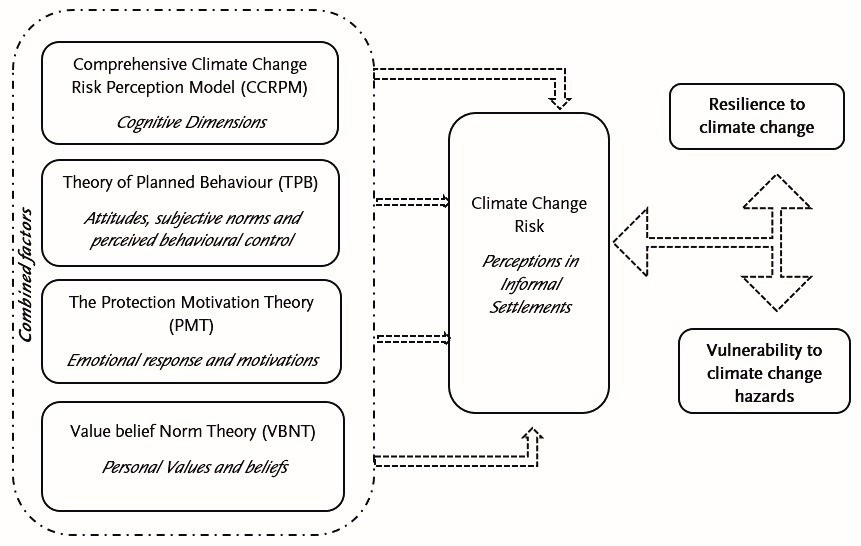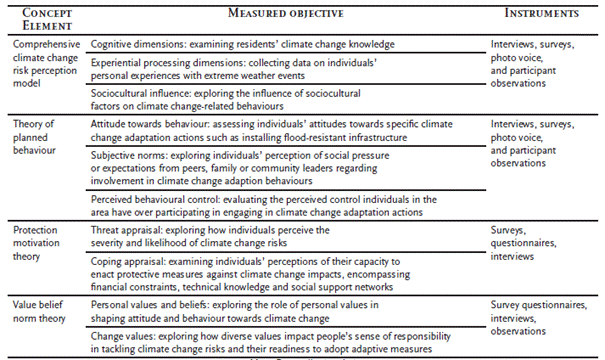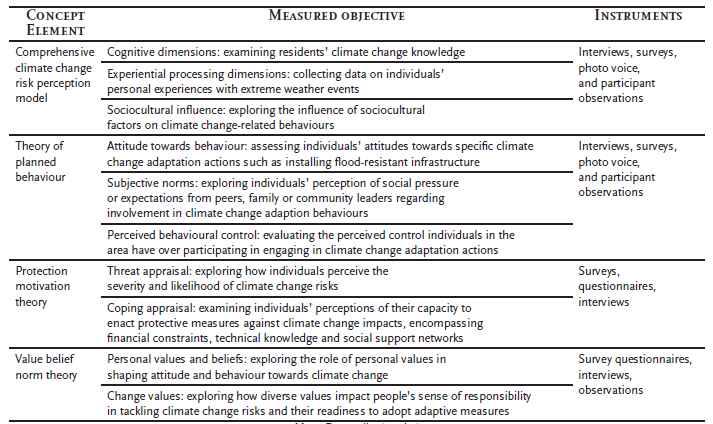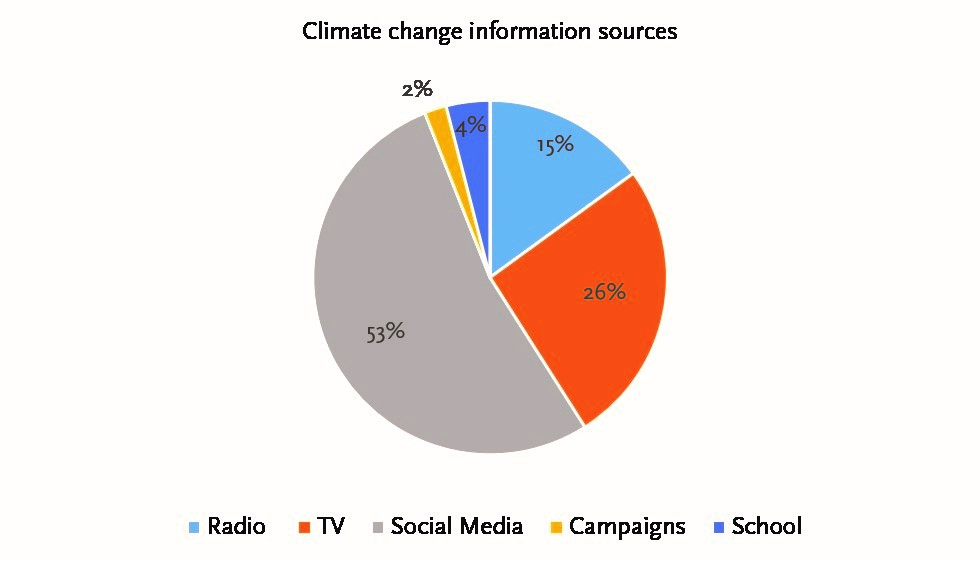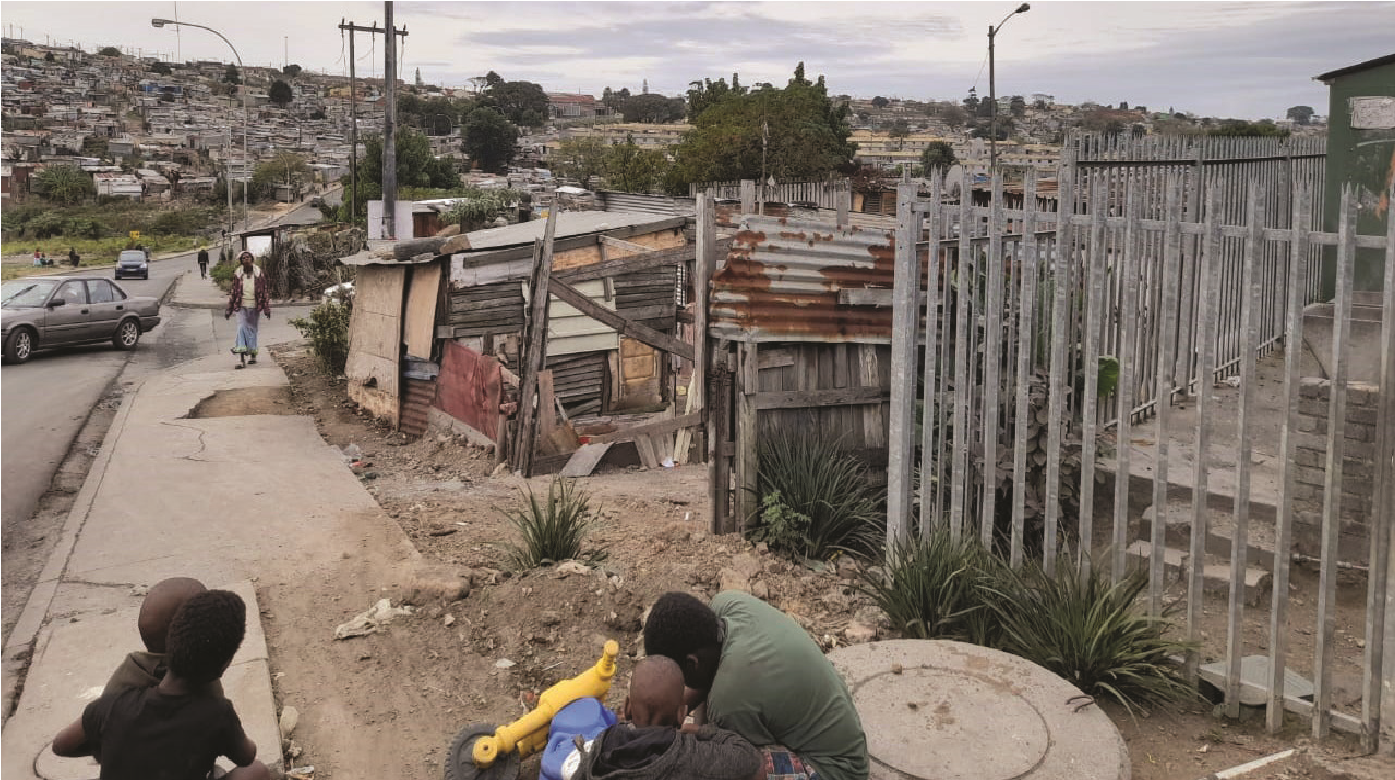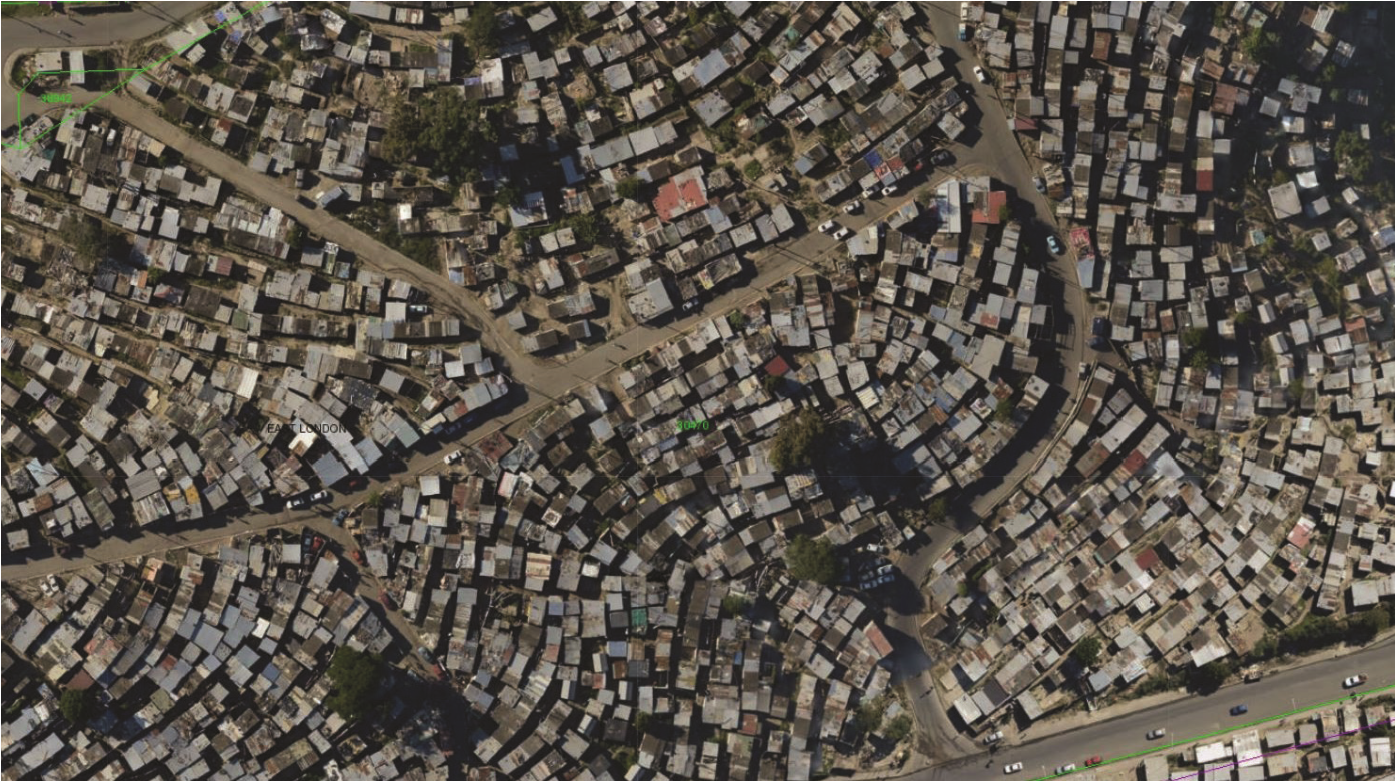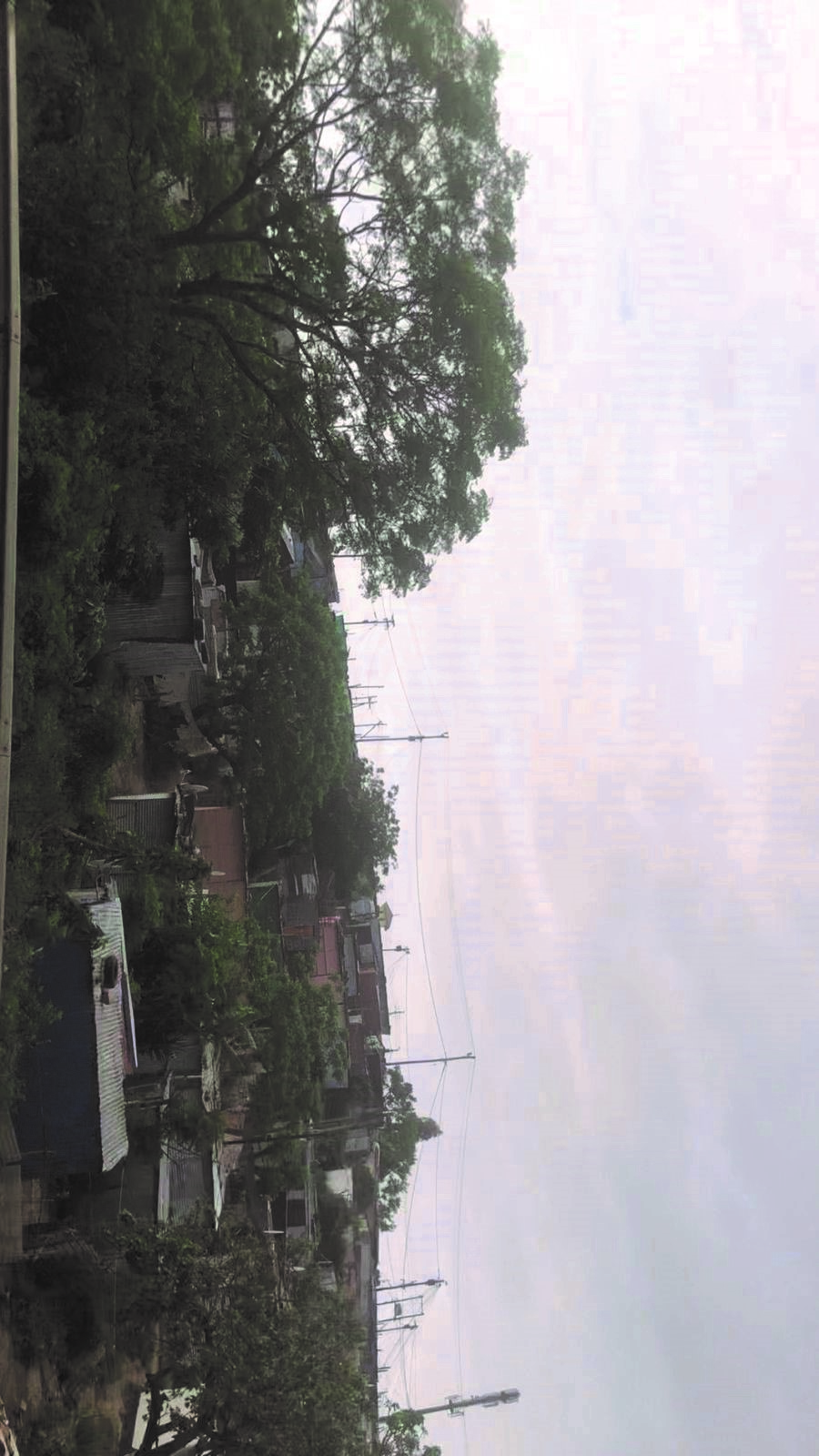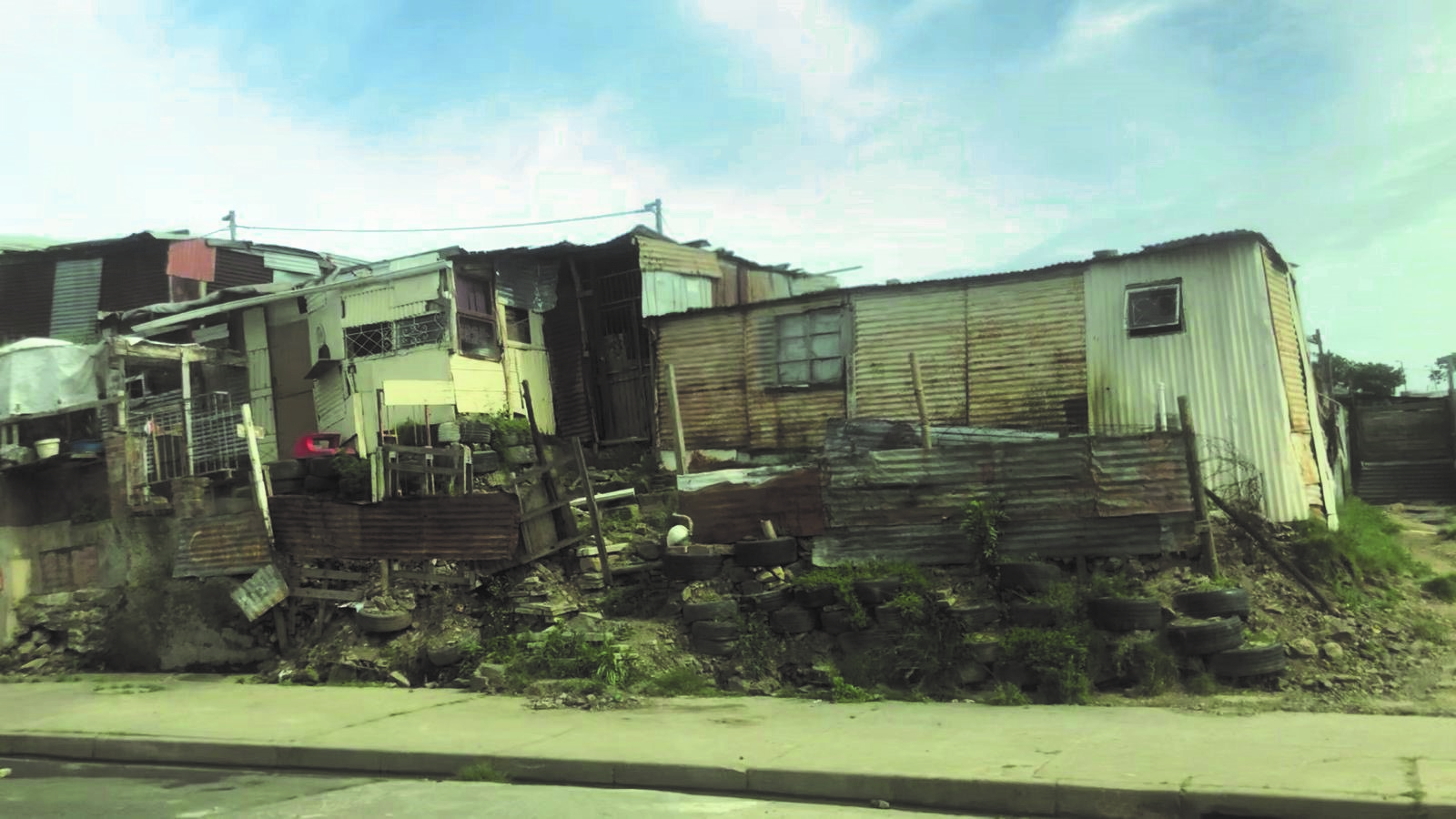1. Introduction
The escalating climate change crisis, marked by more frequent and severe global climate events, presents a major challenge, especially in Sub-Saharan Africa’s urban areas (Intergovernmental Panel on Climate Change, 2022). In these areas, the poor are increasingly vulnerable to rising extreme weather events like floods, heatwaves and droughts, compounded by a clear lack of preparedness for these impacts (van der Walt & Fitchett, 2021). Their vulnerability is further exacerbated by limited access to essential infrastructure and the precarious locations of their homes within urban settings, making these households highly susceptible to even minor climate shocks that can severely impact their livelihoods (Chirisa & Nel, 2022). South Africa has not been spared from this impasse, as evidenced by the increasing frequency and intensity of extreme weather events over the past decade (Drivdal, 2016; Williams et al., 2019). These conditions have resulted in significant infrastructure damage and loss of life, particularly in informal settlements. Recent significant events include the floods in Durban, Cape Town and Buffalo City in 2018, 2022 and 2023 (Grab & Nash, 2023).
This inherent vulnerability has attracted a pressing need to develop adaptation strategies for averting, mitigating, preparing for and recovering from the repercussions of climate change hazards (Mahl et al., 2020). Leiserowitz (2006) contends that public perception, understanding and attitude towards climate change are widely recognised as a crucial factor in tackling this global phenomenon. Consequently, over three decades of extensive research have focused on this topic, with the majority of these studies inclined to the Global North context (Bamberg et al., 2015; Bord et al., 1998; Sullivan & White, 2019). This trend persists despite the sixth assessment report of the Intergovernmental Panel on Climate Change, which states that the impacts of climate change are particularly severe in the Global South, highlighting the urgency of directing greater attention towards this region.
The South African government has undertaken commendable initiatives in its endeavours to mitigate the challenges presented by climate change (Godsmark et al., 2019). However, a significant research gap concerning public perceptions of climate change exists, particularly within the Buffalo City Municipality (BCM) study area and the broader urban South Africa (Dobson et al., 2015). The consensus in the research community underscores the importance of comprehending public perspectives on climate change and their implications for developing low-cost adaptive intervention strategies (van Valkengoed & Steg, 2019). Notably, BCM presents a fragmented and racially splintered urban landscape characterised by stark inequalities, contributing to the disproportionate vulnerability of the poor to climate change hazards (Buffalo City Metropolitan Municipality, 2022; Seethal et al., 2021). This vulnerability, in turn, influences the behavioural inclinations of these groups and shapes their perceptions of the positive or negative consequences associated with climate change hazards (Ballantyne & Oelofse, 1999). Therefore, an imperative exists to elevate public consciousness regarding climate change, leveraging familiarity with pertinent terms and concepts. This stresses the crucial requirement to establish local relevance for climate change by highlighting the intricate links between global climate patterns, behavioural patterns and socioeconomic consequences.
The purpose of the study is to investigate how socioeconomic disparities, the application of localised traditional knowledge systems and cultural norms shape the perceptions of climate change risks among residents of informal settlements and influence their strategies for adaptation. The research explores a complex environment, intricately entwined with beliefs in climate change existence, human influence, awareness of its causes and impact, diverse interpretations of the risks it poses and varying opinions on the community’s role in adapting to its impact. Through a mixed methods approach, the paper delineates the multifaceted nature of public perceptions, documents the range of actions taken in response to climate change, and evaluates their effectiveness. The study aims to provide evidence-based recommendations for policy intervention to assist vulnerable communities. In order to achieve its goals, the research is guided by four principal questions: (a) how do sociocultural, cognitive, motivational and value-based factors influence the perceptions of climate change risks among residents of informal settlements?; (b) what adaptation strategies are employed by residents of informal settlements to mitigate the effects of climate change?; (c) what obstacles hinder effective adaptation in informal settlements?; and (d) what policies could the State enact to enhance support for climate change adaptation in these areas?
The study employs an integrated theoretical framework to achieve a holistic and multidimensional understanding of behaviours related to climate change. This approach explores the intricate interplay between perceptions and actions in the context of climate change impacts within informal settlements. The subsequent sections of this paper are organised as follows: Section 2 delves into the existing literature concerning the interconnectedness of climate change and inequality, the application of localised knowledge in climate change resilience and the socioeconomic factors influencing climate change awareness. Section 3 gives an account of the contextual setting of the case study in BCM; Section 4 delineates the theoretical framework shaping this study; Section 5 explains the research methodology employed; and Section 6 elaborates on the primary findings.
Finally, Sections 7 and 8 provide future research recommendations and conclusions.
2. Literature Review
2.1. The Intersection of Climate Change and Inequality Disparities
Social inequality denotes relational processes within society that result in uneven distribution of rewards or access to opportunities either within or between groups (Gradín et al., 2021; World Bank, 2018). In its diverse manifestation across spatial scales, inequality profoundly impacts human well-being (O’Donnell et al., 2015). In the South African context, spatial inequality is intricately entwined with historical racial legacies, particularly stemming from the apartheid era, and persists as a daunting challenge (Todes & Turok, 2018). This enduring inequality is evident in the entrenched disparities determined by the geographical location of their housing, the provision of infrastructure services, and the presence or absence of economic opportunities (Turok, 2018). Despite the ongoing demographic shifts within the middle class, the impoverished majority often find themselves marginalised in these areas (Kovacevic & Calderon, 2014).
The interconnections between climate change and social inequality are intricate, and a comprehensive understanding of these linkages is still evolving (Singer, 2018). However, Bosetti et al. (2021) contend that the cumulative insights from existing studies indicate that climate change plays a pivotal role in shaping the trajectory of human societies, with its prevalence and intensity contingent upon geographical and socioeconomic factors. Climate change is hastening environmental degradation, marked by an escalating frequency of natural disasters (Nadeau et al., 2022). The repercussions of both gradual environmental deterioration and abrupt shocks disproportionately impact vulnerable populations (Donadelli et al., 2017) and amplify inequality within and between communities (Hsiang et al., 2019). Islam and Winkel (2017) propose three mechanisms by which inequality exacerbates the plight of marginalised groups in the context of climate change. These mechanisms encompass heightened exposure to climate change, heightened vulnerability to the impacts of climate hazards and diminishing capacity to cope with and rebound from such damage.
Following the democratic elections of 1994, the post-apartheid government pledged to diminish inequality, promote economic inclusivity and enhance overall living standards for the average South African citizen (Hundenborn et al., 2018). Despite notable strides in social equity, a lingering truth persists nearly three decades after independence: inequality remains a prominent feature of our society, placing the country among the most unequal globally with a Gini coefficient of 0.67 (World Bank, 2018).
2.2. Utilising Traditional Knowledge for Climate Change Resilience
At the heart of climate change adaptation lies the invaluable resource of Traditional Knowledge Systems (TKS). Embedded within Indigenous practices and local wisdom, TKS encapsulates the collective skills, building practices, myths, beliefs and deep understanding cultivated within specific experiential and dynamic contexts (Ajayi & Mafongoya, 2017; United Nations Educational, Scientific and Cultural Organization, 2017). This reservoir of knowledge plays a pivotal role in shaping residents’ perceptions and awareness of climate change and environmental risks. The intergenerational transfer of TKS fosters a profound connection between people and their natural environment (Leal Filho et al., 2022). Traditional knowledge, passed down from one generation to another, is a repository of adaptive strategies tailored to cope with variable and evolving ecological and social conditions (Mutambisi et al., 2020). In the cognitive realm, TKS frequently offer invaluable insights into local weather patterns, seasonal changes and sustainable adaptive practices in response to climate hazards (Makondo & Thomas, 2018). These insights, honed over time through direct experiences and observations, enhance individuals’ understanding and recognition of environmental dynamics. This knowledge forms a foundation for community resilience in the face of climate challenges (Mbah et al., 2021). In the event of shocks or threats, local communities apply this information, often transmitted orally, to adapt to environmental challenges (Mugambiwa & Makhubele, 2021). This suggests a high level of informality in the transmission of knowledge, which is predominantly oral, largely undocumented and rooted in everyday experimentations, adaptations and innovations driven by the pragmatic demands of daily life (Ajayi & Mafongoya, 2017). The multifaceted nature of traditional knowledge systems thus emerges as a dynamic and adaptive resource, deeply ingrained in the cultural fabric of communities and playing a crucial role in fostering resilience and sustainability in the midst of environmental uncertainties.
Petzold et al. (2020) contend that the essential role of local and traditional knowledge in climate change adaptation within informal settlements is often overlooked, leading to government disaster mitigation measures that do not adequately reflect local nuances or integrate community practices and knowledge (Audefroy & Sánchez, 2017). This oversight affects both formal and informal local mechanisms shaping social norms and individual behaviours, thereby reducing the efficacy, impact and value of these traditional systems (Briggs, 2005). Recognising the role of TKS is crucial for enhancing climate change adaptation and resilience, which is vital for achieving the objectives of Agenda 2030 and the Paris Agreement.
2.3. Exploring the Sociocultural Dimensions of Climate Change Perception and Awareness
Climate change has permeated the spaces of everyday life, with society’s response intricately intertwined with sociocultural dimensions (Adger et al., 2013). Although culture lacks a single definition, it is commonly conceived as comprising identity, values, practices, taboos, worldviews, norms and objects, collectively establishing shared meanings across different contexts (Faulkner et al., 2006; Katrini, 2018). These cultural components significantly influence individuals’ understanding, perception and responses to climate change risks, impacting how they interpret, prioritise, act upon, and perceive their role in addressing the phenomenon (Roncoli et al., 2016; Quandt, 2019). Sociocultural norms represent shared societal expectations and behaviours that guide actions across different situations. Therefore, understanding and leveraging these norms related to risk tolerance, trust in information sources, action prioritisation, and response acceptance are essential for promoting adaptive and sustainable practices at both individual and community levels (Few et al., 2020).
Moreover, culture is pivotal in shaping society’s interaction with natural and environmental systems (Price et al., 2014). However, Bennoune (2020) emphasises the dynamic nature of cultural values, which are constantly evolving and influenced by factors such as class, gender, health, social status, and ethnicity, rather than being static. Within local contexts, cultural aspects are generated and sustained through formal and informal institutions, which strongly influence opportunities for action (Thomalla et al., 2015). Consequently, communities must continuously adapt by reassessing and adjusting their value systems to mitigate and prepare for climate change risks, identifying barriers and facilitators to effective risk management (Davies et al., 2019). O’Brien and Wolf (2010) contend that deviations from established norms may be perceived as threatening, impacting decisions to adopt new variables based on individuals’ or groups’ cultural and social permission or opportunities to access available options. This dynamism may sometimes foster resistance to change (Antwi-Agyei et al., 2015), perpetuating a cycle of outcomes and exacerbating the risk exposure of individuals and communities.
Nonetheless, cultural norms should not solely be perceived as obstacles to adaptation as they can also facilitate or offer pathways for livelihood diversification as adaptive measures (Burch, 2011). Recognising and navigating these complexities of cultural influence is crucial for achieving more equitable and sustainable efforts (Curry et al., 2015). These perspectives shed light on the diverse responses observed within the case study in BCM, highlighting the importance of understanding the causal relationship between culture and climate change perceptions and awareness.
3. Study Context
BCM is situated in South Africa’s Eastern Cape province and obtained metropolitan status in 2011 by amalgamating small towns of King Williams’ Town, Bisho, East London and surrounding hinterlands. The metropolitan area consists of an impoverished population where approximately 25% of its residents live in informal settlements, representing 40% of the total households in the province (Buffalo City Metropolitan Municipality, 2022). Informal settlements are rapidly growing in areas once designated as “buffer zones”, which are largely unsuitable for development and susceptible to severe weather events. Consequently, places like Duncan Village (DV), Mzamomhle and Nompumelelo informal settlements face ongoing climate-related risks such as floods, rising temperatures, fires, strong winds and water shortages (Busayo et al., 2019). DV, located 5 km from the East London CBD, is the municipality’s most densely populated informal settlement (Buffalo City Metropolitan Municipality, 2022). The area was selected purposefully for its unique geographical, spatial, political and historical significance that predates the 1880s, marked by Black labour resistance against government attempts to relocate residents to designated Black townships (Seethal et al., 2021). The area is also recognised as a major disaster hotspot due to its unique topography, characterised by undulating terrain, resulting in diverse landscapes of riverbanks and steep valleys. These features divide the area into three distinct districts with varying altitudes (Kienest, 2019).
4. Conceptual Framework of Study
Climate change hazard and risk perceptions do not necessarily follow linear progression but emerge from a complex interplay of cognitive, sociocultural, motivational and value-based factors (Lee et al., 2015). This understanding is vital for formulating impactful and efficient responses to climate change, particularly in informal settlements where socioeconomic vulnerabilities intersect with environmental risks, necessitating the creation of contextually appropriate intervention strategies. The study combines four theoretical models: the comprehensive climate change risk perception model (CCCRPM), the theory of planned behaviour, the protection motivation theory and the value belief norm theory, which are briefly discussed in the following section.
4.1. Comprehensive Climate Change Risk Perception Model
The theoretical model is an integrative social-psychological model that integrates three core dimensions of risk, including cognitive factors, experiential factors and sociocultural factors (van der Linden, 2017). The cognitive dimensions comprise knowledge about the causes, impacts and responses to address climate change. The experiential processing dimension includes affect and personal experience with extreme weather events. Lastly, the sociocultural influences include social norms and value orientations. This model serves as an overarching framework that can incorporate elements from other theories.
4.2. Theory of Planned Behaviour
The theory focuses on predicting and understanding individual social actions by emphasising the roles of attitudes toward the behaviours, subjective norms and perceived behavioural control (Ajzen, 1985). Subjective norm refers to the perceived social pressure to perform a behaviour shaped by others’ expectations and an individual’s access to resources like time, money and knowledge (Manstead & Parker, 1995). Integrating the theory of planned behaviour into the comprehensive model will enhance understanding of behavioural intentions related to climate change adaptation in informal settlements by assessing attitudes, subjective norms and perceived behavioural control.
4.3. Protection Motivation Theory
The theory provides a framework for understanding how fear appeals drive behavioural change (Rogers, 1975), positing that individuals’ responses to perceived threats involve two cognitive processes: coping and threat appraisal. Threat appraisal considers the severity and susceptibility of the threat and the benefits of maladaptive responses (Norman et al., 2015), while coping appraisal evaluates the effectiveness of adaptive responses based on self-efficacy and response costs (Prentice-Dunn & Rogers, 1986). Incorporating protection motivation theory into the analysis offers motivational insights into how individuals in informal settlements perceive climate change risks and their effectiveness in implementing protective measures.
4.4. Value Belief Norm Theory
The theory outlines how human values dictate action choices through a sequential causal pathway that connects beliefs, norms, values and behaviours (Stern et al., 1999). It defines values as fundamental principles that guide behaviour, prioritised by their importance across situations (Schwartz, 1992). Key variables include understanding consequences, assigning personal responsibility and personal norms, altruistic, biospheric, egoistic, and openness to change, which are identified as essential components. By integrating value belief norm theory, one can analyse how personal values and beliefs shape attitudes and behaviours towards climate change. This offers a framework that accounts for the impact of underlying values on individuals’ perceptions and responses, thus enhancing the understanding of their climate-related attitudes and actions.
By integrating these frameworks, illustrated by Figure 1, the conceptual model provides a comprehensive approach to understanding the multifaceted nature of climate change perceptions and behaviours in informal settlements. It considers cognitive, emotional, motivational and cultural factors, which in turn influence the resilience or vulnerability of these communities to climate change hazards. The proposed conceptual model will be the foundational framework guiding the research design and methods in the following section.
5. Research Design and Methods
The study employed a mixed-method approach during data collection in BCM, spanning from January 2022 to March 2023. Guided by the climate change hazard and risk perception (CCHRP) conceptual model, the study delineated specific objectives for each conceptual element, guiding the selection of research instruments that included participant observations, photo voice, semi-structured interviews, questionnaire interviews and a focus group as illustrated in Table 1. The study began with an initial observation of the study setting to analyse factors influencing susceptibility to climate change hazards, such as infrastructure, environmental conditions and community dynamics. These observations informed the design of data collection instruments, enabling local residents to participate and share their experiences and knowledge regarding climate change and coping mechanisms.
The survey utilised 249 structured household questionnaires, employing both purposive and random sampling techniques to ensure diverse demographic representation. This approach included age groups of 18-30 years (25%), 31-45 years (30%), 46-60 years (32%), and 61+ years (13%), along with a gender distribution of 47% female and 53% male participants. It also accounted for variations in socioeconomic status and educational background, thereby capturing a broad spectrum of viewpoints. Following an evaluation of current conditions in the case study area, semi-structured interviews were conducted with various stakeholders, including community leaders, BCM city planners, disaster management units and non-governmental organisations. These interviews aimed to gather stakeholders’ insights regarding the area’s observed realities. Secondary data sources from State institutions, such as StatsSA, BCM and the Department of Cooperate Governance and Traditional Affairs, were also utilised to ensure a well-rounded understanding of the complex factors influencing residents’ perceptions, attitudes, beliefs and behavioural intentions towards climate change. Thematic analysis was employed to discern patterns and narratives within the survey data, specifically concentrated on socioeconomic conditions, settlement and building typology and the impact of the political landscape on vulnerability to climate change hazards.
6. Findings and Discussions
6.1. Education Status
The intersection of educational attainment and climate change risk perception in DV highlights the dynamics of knowledge, behaviour and vulnerability as conceptualised by the CCHRP model. The survey reveals that a significant portion of respondents lack formal education, with 4% (n=10) having no structured education and 27% (n=67) only completing primary school. This educational gap limits their ability to perceive and evaluate climate risks accurately, thus constraining their engagement in proactive behaviours, a finding that resonates with the cognitive dimensions of the CCCRPM framework and the theory of planned behaviour. This aligns with Adger et al. (2013), who noted that cognitive knowledge plays a critical role in how individuals assess climate risks and their subsequent vulnerability.
Conversely, respondents with secondary education 42% (n=102) and tertiary education 19% (n=47) are more likely to have a comprehensive understanding of climate issues, enhancing their capacity to engage in decision-making and resilience-building activities. This observation is supported by Satterthwaite et al. (2020), who highlight the significant role that higher education plays in empowering individuals to contribute to climate change mitigation and adaptation efforts effectively. Moreover, the theory of planned behaviour suggests that education can profoundly influence attitudes and perceived behavioural control, fostering positive climate actions. Nonetheless, the protection motivation theory and the value belief norm theory introduce a broader perspective, indicating that while education enhances threat and coping appraisals, experiential and contextual factors are vital in shaping perceptions and adopting protective actions against climate change hazards. Therefore, while addressing educational disparities is crucial, it is equally important to incorporate experiential and contextual factors into climate change adaptation strategies.
6.2. Economic Status
The exploration of income status among DV residents reveals a nuanced socioeconomic landscape that deeply impacts their vulnerability and resilience, as outlined by the CCCHRP model. A striking 71% of respondents are not formally employed, underscoring a severe economic vulnerability that hampers access to resources and information critical for adopting climate-resilient practices (Donadelli et al., 2017; Islam & Winkel, 2017). The planned behaviour theory helps explain how economic instability affects residents’ intentions and perceived control over climate-related actions, with many relying on inconsistent income sources like government grants or informal jobs. This compels them to prioritise immediate daily needs over long-term climate resilience investments, a scenario supported by the protection motivation theory, which suggests that financial limitations constrain proactive climate strategies.
Moreover, the value belief norm theory sheds light on how entrenched socioeconomic disparities, a legacy of apartheid-era planning in DV, shape community norms and influence attitudes towards climate change adaptation. These historical and structural inequalities skew residents’ perceptions and behaviours under economic pressures, illuminating the intricate relationship between economic status, vulnerability and climate change perceptions. Singer (2018) highlights that socioeconomic factors significantly influence the capacity to adapt to environmental changes, underscoring the importance of considering these factors in climate adaptation planning. Consequently, findings from DV suggest the need for targeted efforts to bridge socioeconomic gaps in climate resilience strategies to ensure they are inclusive and effective.
6.3. Climate Change Knowledge and Information Sources
Exploring climate change knowledge among DV residents reveals critical gaps and opportunities for enhancing community engagement and understanding. Despite 38% of respondents claiming some knowledge of climate change, there remains a substantial lack of comprehension of its causes and impacts. This points to a crucial need for targeted educational initiatives aligned with the CCCRPM framework, designed to address prevalent misconceptions such as attributing climate change solely to high temperatures, Western nations or corruption. This finding aligns with van der Linden et al. (2017), who explored how public misinformation affects individual and group behaviours, emphasising the necessity for accurate threat appraisals as advocated by the protection motivation theory to foster protection behaviours.
Moreover, integrating IKS could significantly enrich educational content, providing insights into local environmental conditions and adaptive strategies. This approach aligns with the value belief norm theory, highlighting the importance of culturally embedded norms and beliefs in shaping environmental behaviours (Leal Filho et al., 2022; Makondo & Thomas, 2018). The predominant use of social media by 52% of respondents points to digital platforms like Twitter, Facebook, WhatsApp and TikTok as effective tools for disseminating climate knowledge, resonating with the theory of planned behaviour, which posits that accessible information sources can influence attitudes and perceived behavioural control. However, the underutilisation of traditional media sources such as radio (15%), television (26%), campaigns (2%) and schools (4%), illustrated in Figure 2, highlight a gap in utilising diverse communication strategies that combine digital and traditional media to maximise outreach and engagement effectively.
The high levels of community participation (76%) and willingness to learn about climate change (82%) in DV present a fertile ground for community-driven educational programs that blend scientific facts with IKS. Such initiatives could profoundly enhance understanding, foster a sense of ownership and empower the community effectively.
6.4. Climate Change Hazards Personal Experiences
Participants from the DV informal settlement have had varying degrees of exposure to climate hazards. Based on their personal experiences, the respondents were asked the following question: “on a rating of 1-4, where 1 is the least, and 4 is the most. Have you experienced damage to property or ill health issues due to heavy rains, floods, heat waves and any other climate change hazard? Please explain what happened”.
The varying degree of exposure to climate change hazards among participants, illustrated by Figure 3, reveals a broad spectrum of impacts and perceptions, aligning with the CCCRPM. This variation profoundly shapes individuals’ and collective understanding and responses to climate risks. For instance, 10% of participants who reported the least impact may view climate change as minimally disruptive, potentially due to effective adaptation measures or simply a lack of awareness, aligning with the theory of planned behaviours, which suggests that perceptions can shape behavioural responses.
Conversely, 15% of participants who have experienced moderate impacts are likely more conscious of their vulnerability, experiencing disruptions that affect their everyday lives. This heightened awareness may trigger protective behaviours as outlined in the protection motivation theory, emphasising the role of perceived severity and susceptibility in motivating adaptive actions. The largest segment, comprising 55% of respondents, reports significant impacts, which likely enhances their risk awareness and drives a community-wide acknowledgement of climate threats, reflective of the shared social norms and beliefs highlighted in the value belief norm theory. This shared experience can promote stronger community norms towards proactive climate risk management. Moreover, the 20% of respondents experiencing the most severe impacts, including substantial personal or property losses, represent the most risk-aware group. Their dire circumstances may catalyse active mitigation efforts, corroborated by the protection motivation theory, in order to enhance community cohesion and deepen commitment to collective action during disaster recovery phases.
6.5. Building Typology
DV residents’ building typologies and techniques, illustrated in Figure 4, Figure 5 and Figure 6, provide a multifaceted adaptation strategy highlighting valuable insights into climate change risk and community vulnerability. Utilising zinc and cardboard/ plank structures, employed by 78% of respondents, reflects a cognitive acknowledgement of the community’s economic limitations and the need for rapid reconstruction post-disaster. Such reliance on readily available and inexpensive materials reflects a practical response to DV’s contextual realities and aligns with findings in similar economically constrained settings (Satterthwaite et al., 2020; Williams et al., 2019) and underscores the community’s vulnerability due to limited protection against extreme weather events.
By incorporating the theory of planned behaviour, it becomes apparent that construction choices in DV are influenced not just by practicality but also by communal norms and perceived constraints around more resilient building options. Additionally, the protection motivation theory sheds light on residents’ threat and coping appraisals; the prevalent use of quick-to-assemble materials reflects a coping mechanism aimed at addressing immediate shelter needs post-disaster, which, while practical, may not substantially mitigate long-term vulnerabilities. This points to a protective motivation driven more by necessity than optimal choice, favouring immediate practical solutions over more sustainable but less accessible alternatives.
The community’s involvement in building activities reflects the value belief norm theory, highlighting how social norms influence resilience enhancement practices (Aldunce et al., 2016). However, notable gender disparities in construction roles, with 85% of male respondents personally building their shelters compared to 90% of females relying on external help, highlight a divergence from inclusive community involvement. This discrepancy could hinder the community’s overall ability to recover swiftly from disasters, indicating a crucial area for intervention.
Overall, the building techniques in DV not only reflect responses to economic and physical challenges but also embody deeper community values concerning self-reliance, resilience and gender roles. These normative beliefs shape the community’s collective responses to climate hazards, determining participation in construction and potentially reinforcing existing vulnerabilities, particularly among women.
6.6. Shelter Upgrade as a Climate Change Adaptation Strategy
The housing maintenance observed in DV offers insightful reflections on the community’s knowledge of climate change risks and their perceptions of vulnerability. Analysis reveals that 41% of respondents neglect maintenance or alterations to their residences, indicating a notable gap in threat appraisal and pointing to a general unawareness of the importance of regular upkeep in adapting to changing climate conditions. This neglect could potentially compromise building integrity and increase vulnerability to damage during severe weather events, underscoring a critical area for intervention. Conversely, those residents who actively maintain their homes exhibit a proactive approach to safety, aligning with the protection motivation theory, which suggests that individuals who recognise potential risks are more likely to take preventive actions against them. This behaviour contrasts sharply with the broader trend of maintenance neglect and highlights the community’s varying levels of risk awareness.
Economic and social factors significantly impact housing modifications in DV, where financial limitations and perceptions of temporary housing hinder climate-resilient upgrades (Mthembu & Hlophe, 2020). These challenges, common in other regions, must also be addressed to enhance DV’s climate resilience. Additionally, some DV residents view housing improvements as a responsibility of the State, reflecting broader social norms and the impact of government policy on individual actions, as explained by the value belief norm theory. There exists a concern that personal investments in housing might jeopardise eligibility for government schemes, highlighting a unique tension between personal action and public policy that could contribute to social justice and equity challenges. This issue is sparsely reflected in existing literature, marking a distinct aspect of the DV context where fear of losing benefits may inhibit proactive climate adaptation measures.
Furthermore, the minimal involvement in external maintenance tasks like drainage, often perceived as a municipal duty, suggests a trend of passivity in personal contributions to adaptation. This stands in contrast to literature that emphasises the importance of community and individual engagement in enhancing resilience to climate impacts.
Overall, the housing maintenance behaviours in DV reflect a complex interplay of economic constraints, government expectations and varying levels of awareness regarding the necessity for climate change-resilient housing upgrades. While some residents demonstrate an understanding of and responses to these needs, illustrated by Figure 7 and Figure 8, others face significant barriers that impede their ability to implement substantial improvements.
6.7. Political Dynamics in Shaping Risk Perceptions
In exploring the intricate relationship between political dynamics and climate change risk perceptions in DV, we delve into a complex tapestry where historical, social and political factors converge, profoundly shaping the community’s vulnerability to climate hazards.
The enduring legacy of apartheid spatial planning continues to profoundly affect BCM, perpetuating segregation and exclusion that shape urban development (Seethal et al., 2021). This historical context has led to a considerable housing shortage and heightened social tensions (Siyongwana & Chanza, 2017), driving vulnerable communities in DV into hazard-prone areas where risks are intensifying, as observed during data collection. Such conditions have deepened residents’ awareness of their historical and current environmental situations, influencing how they perceive and react to climate risks. Lacking access to formal housing, DV residents are forced to settle in economically strategic areas, yet densely populated and lacking essential services. Respondent 1 (interview, February 5, 2022) narrated her experience of living in DV without essential services as follows:
I have lived in DV for over five years and consistently faced challenges accessing clean water. My house lacks electricity; hence, l use paraffin for cooking, and l use a communal toilet situated more than 100 m from my home. Garbage collection in the area is random. These living conditions are quite traumatic for me and my family, but due to our limited options, we will stay.
Satterthwaite et al. (2020) highlight how such settings are ripe for both health and climate hazards, further exacerbating the residents’ susceptibility to climate impacts. Moreover, settling on land without secure tenure further compounds their vulnerability and reflects the protection motivation theory, where the perceived lack of support from authorities fosters a sense of helplessness, diminishing the drive to pursue climate-resilient housing modifications. Respondent 2 (interview, February 5, 2022) explained:
I cannot upgrade this shelter because I would be wasting money on repairs to a temporary structure that could be destroyed by fire or rain at any time. I should save my money so that when l finally receive my house from the government, l can extend it to accommodate my large family comfortably. However, I am disappointed by the slow pace of the government in building houses, as l have been on the waiting list for more than ten years; it almost feels like an empty promise.
Political competition for low-income housing introduces another layer of complexity. Promises made by political parties regarding infrastructure development frequently go unfulfilled, leading to various strategies such as “jumping the queue” for housing, typically involving land invasions in areas designated for key city infrastructure development (Buffalo City Municipality town planner, interview, April 11, 2022). These tactical strategies, often orchestrated by political figures, compel the government to arrange alternative housing for the displaced occupants to continue with development plans (local- non-governmental organisation respondent, interview, May 16, 22).
Political interference in land administration is prevalent, with allegations of councillors exploiting unemployed youths for personal gain, contributing to irregular land allocations and private sales (Duncan Village community leader 1, interview, October 17, 2022). This disadvantages long-standing residents and benefits newcomers, and as a result, such practices undermine community cohesion and foster tensions and distrust among residents. According to the theory of planned behaviour, such political instability and unreliable governance profoundly influence residents’ intentions to engage in housing modifications. Prominent political figures redirect resources to favour their allies, and corruption allegations within the municipality strain relations between councillors and ward committee members (Duncan Village community leader 2, interview, October 17, 2022). This can impede effective disaster management initiatives, reflecting the influence of social norms and trust in institutions, as outlined in the value belief norm theory. Residents may perceive corruption as a barrier to accessing resources and support for climate resilience efforts, leading to a sense of vulnerability and mistrust. Political infighting and corruption can divert resources from crucial climate resilience and disaster preparedness efforts.
In summary, the political dynamics within BCM areas significantly shape the knowledge of climate change risk and perceptions of vulnerability within DV. Addressing these issues requires a nuanced understanding of the interplay between historical legacies, socioeconomic challenges and political integrity, all of which are vital for fostering a resilient and informed community capable of confronting the challenges posed by climate change.
7. Recommendations and Conclusion
Addressing climate change perceptions and enhancing resilience in vulnerable enclaves like DV in BCM, South Africa, requires a multifaceted approach. This community, shaped by a complex interplay of socioeconomic vulnerabilities, historical legacies and political dynamics, faces unique challenges that demand tailored interventions. Through the comprehensive study of these dynamics, several strategies are recommended to mitigate the impacts of climate change hazards and promote sustainable development.
Social media platforms like Twitter, Facebook, WhatsApp and TikTok are pivotal in disseminating climate change information and fostering community engagement. Recognising the role of these platforms as primary information sources in DV, targeted climate change awareness campaigns can be designed to broadcast information in the local native language to engage users interactively. By positively influencing attitudes and behaviours towards climate change, these initiatives harness the planned behaviour theory, emphasising the importance of accessible communication channels in shaping public perception and driving proactive engagement. Moreover, integrating IKS into climate change education presents a significant opportunity to enhance the cultural relevance and impact of learning initiatives. This approach taps into the value belief norm theory by organising community-led workshops and storytelling sessions and incorporating indigenous practice into school curricula. It recognises the deep-seated cultural dimensions of climate change perceptions and behaviours, making education more meaningful and effective for DV residents. This strategy respects and revitalises local knowledge and also strengthens community resilience by aligning traditional practices with scientific climate adaptation strategies.
Another critical area of focus is addressing gender disparities in climate resilience. By initiating training programs specifically designed for women in construction skills, the community can promote gender equity and empower women to actively participate in building climate-resilient infrastructures. This initiative aligns with the principles of both the protection motivation theory, which focuses on enhancing individual capacity to respond to perceived threats and the value belief norm theory, which underscores the role of societal values and norms in motivating environmentally beneficial behaviour. To further bolster resilience in DV, government agencies like the National and Provincial Department of Human Settlement, local non-governmental organisations and the private sector are encouraged to facilitate access to climate-resilient housing. Supporting programs that upgrade and retrofit shelters in the area is essential in reducing economic vulnerabilities. This can be achieved by providing subsidised circular building materials, technical assistance in construction and promoting climate-resilient building practices. These steps are crucial in aligning with the CCCHRP model, highlighting the importance of addressing cognitive and material capacities to cope with climate risks.
In conclusion, this study has rigorously analysed the influence of socioeconomic disparities, IKS and cultural norms on the perceptions and adaptive responses to climate change among residents of DV’s informal settlements. The findings highlight the profound impact these factors exert on residents’ understanding of climate change, its causes and the roles they perceive as pertinent to their community’s mitigation efforts. Employing a mixed methods approach to explore the complex interplay of sociocultural, cognitive, motivational and value-based factors that shape these perceptions, guided by the CCCHRP theoretical framework. The study records various adaptive practices and assesses their effectiveness, revealing that while some strategies are beneficial, numerous barriers such as economic constraints, limited access to technology, inadequate educational resources and political challenges impede successful adaptation. These findings inform targeted interventions aimed at bridging knowledge gaps and enhancing adaptive capacities in informal settlements.
Consequently, the study recommends contextually appropriate policy measures that enhance educational outreach to improve climate literacy, seamlessly integrate IKS into climate adaptation planning and improve infrastructure support. These measures are pivotal in diminishing vulnerabilities and enhancing the adaptive capacities of informal settlement residents. The recommended strategies adopt a holistic approach, which is essential for developing interventions that tackle immediate climate risks and aim for long-term sustainability and resilience.











 texto em
texto em 


